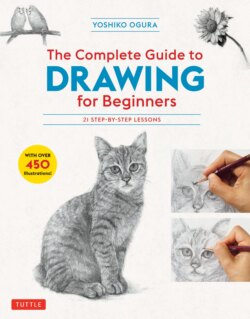Читать книгу The Complete Guide to Drawing for Beginners - Yoshiko Ogura - Страница 9
На сайте Литреса книга снята с продажи.
ОглавлениеPencil pressure The pressure applied to the tip of a
pencil when drawing. A wide range of expression can be
realized by varying the pressure as you draw.
Perspective A method of visually expressing a three-di-
mensional space on a two-dimensional plane, thereby
creating the illusion of depth. Generally, one-point
perspective (page 57) is the most familiar. It is used to illustrate the implied distance from an object’s front to its back. One-point perspective, two-point perspective and three-point perspective respectively increase the sophistication and realism of drawings. Perspective is widely used not only in drawing but also in various other fields of visual expression (construction, animation, cartooning, illustration, etc.).
One-point perspective A technique for depicting
depth where lines converge toward a single vanish-
ing point. See page 57.
Two-point perspective A technique for depicting
depth where lines converge toward two vanishing
points. See page 57.
Three-point perspective A technique for depicting
depth where lines converge toward three vanishing
points. See page 57.
Plaster statue A three-dimensional plaster model. Be-
cause the model is completely white with easy to
understand contours, it is often used as an object for
drawing studies. Classical Greek and Renaissance sculp-
tures are typically used as prototypes.
Reflected light Diffuse light that has been bounced
back from the surface or surfaces closest to the object.
By depicting reflected light, you can impart a realistic
three-dimensional effect to the subject. See page 28.
Saturation The degree of color depth. Vivid colors ex-
hibit high saturation, and faded colors exhibit low
saturation.
Shade The darker area on an object when light from the
light source has been blocked by something (including
parts of the object itself). See page 28.
Shadow Shadows are cast on the side of an object
opposite to the light source. See page 28.
Shaping Roughing in the shape and shades of the ob-
ject at the outset of a drawing project.
Skeletal Structure The underlying structure of verte-
brates, comprised of the jointed bones and cartilage.
Drawing accurate human or animal forms is much easier
if you are able to envision the skeleton as you draw.
Sketching The act of drawing quickly, primarily with
simple lines and no shading, capturing the features
and poses of subjects such as people and animals. Also
called Croquis (pronounced “croaky”) drawing. See
page 114.
Sketch lines Light lines quickly put down when rough-
ing in a shape. They help the artist gradually ascertain
where the edges of the object being drawn should
appear in the finished drawing.
Space In the real world, a three-dimensional expanse
that we all inhabit. In drawing, techniques must be used
to emulate the look of three-dimensional space, such
as using contrasting bold and thin lines, dark and light
tones, and sharp and fuzzy details. See page 35.
Structure The individual underlying shapes that together
form the overall shape of an object. For drawing
people and animals, it is important to understand how
the skeleton and muscles fit together to affect the bal-
ance and form of the subject.
Surface The visible part of the object you are drawing.
The surface is gradually roughed in and refined with
shading, highlights, shadows, textures and other details
to present a realistic representation of the physical
object being drawn. See page 38.
Texture The visual representation of the tactile feel of
the real-world subject through the skillful application of
pencils and the kneaded eraser. See page 34.
Three-dimensional effect The illusion of depth created
through the use of perspective, shading, and using bold,
dark, sharp lines on parts of the drawing that are to
appear closer to the viewer and thin, light, fuzzy lines on
parts of the drawing that are to appear farther from the
viewer.
Tone The color of the surface of an object. The play of
light and shadows across the surface of the object being
drawn is emulated through the use of gradation, with
shades of gray mimicking the color saturation of the
subject.
Vanishing point A point on the horizon of a drawing to
which receding parallel lines converge. See page 56.
9
